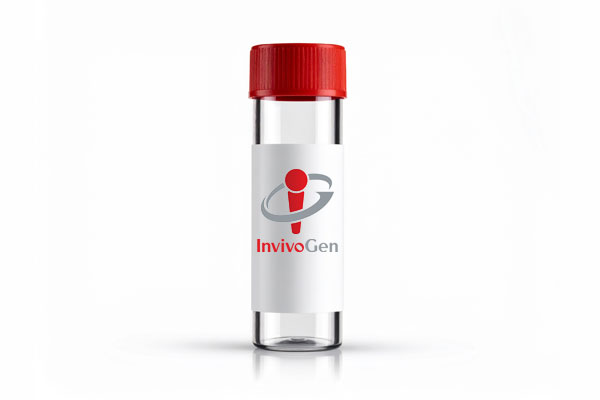Anti-hCD70-hIgG1fut
-
Cat.code:
hcd70-mab13
- Documents
ABOUT
Anti-human CD70 antibody - Human IgG1 non-fucosylated (high effector functions)
Anti-hCD70-hIgG1fut is a Vorsetuzumab biosimilar with an engineered non-fucosylated (fut) IgG1 isotype. Vorsetuzumab is a humanized IgG1 mAb targeting the immune checkpoint (IC) molecule CD70 (aka CD27 ligand or CD27L). This mAb can kill tumor cells through antibody-dependent cell-mediated responses (ADCC & ADCP). Currently, a non-fucosylated version of this mAb (SEA-CD70) is undergoing clinical evaluation in a phase I study in patients with myeloid malignancies (NCT04227847).
Anti-hCD70-hIgG1fut comprises the variable region of Vorsetuzumab and a non-fucosylated IgG1 constant region for even higher effector functions (see figure).
Key features
- Each lot is functionally tested and validated
- The complete sequence of the antibody construct has been verified
- Absence of endotoxins determined by the EndotoxDetect™ assay
All products are for research use only, and not for human or veterinary use.
SPECIFICATIONS
Specifications
CD70
Human
Sodium phosphate buffer with glycine, saccharose, and stabilizing agents
Negative (tested using EndotoxDetect™ assay)
Flow cytometry, ELISA, ADCC assay, Fc interaction studies
Each lot is validated by flow cytometry.
CONTENTS
Contents
-
Product:Anti-hCD70-hIgG1fut
-
Cat code:hcd70-mab13
-
Quantity:100 µg
Shipping & Storage
- Shipping method: Room temperature
- -20°C
- Avoid repeated freeze-thaw cycles
Storage:
Caution:
Details
The Cluster of Differentiation CD70 (aka CD27L, TNFSF7), a member of the TNFR family, is known as the sole ligand for CD27. The CD27–CD70 costimulatory receptor-ligand pair plays an important role in immune regulation. In concert with the T cell receptor (TCR) crosslinking, it promotes T cell activation, proliferation, survival, maturation of effector capacity, and T cell memory [1-2]. CD70 is primarily expressed on antigen-presenting cells (APCs) and upon interaction,with T cell-expressed CD27, it initiates the necessary signaling required for the proliferation and differentiation of antigen-specific T cells. Interestingly, it has been established that CD70 itself is transiently expressed on T cells after their activation. Evidence shows that T cell-expressed CD70 plays an important immune checkpoint role in the suppression of inflammatory T cell responses by a number of mechanisms including the upregulation of inhibitory immune checkpoint molecules [3]. Thus, the expression of CD70 on T cells has the ability to ameliorate inflammation and therefore, may be beneficial in the treatment of inflammatory diseases, such as inflammatory bowel disease (IBD) and graft-versus-host disease (GVHD) [3].
Constitutive overexpression of CD70 has been described in a range of solid and hematological malignancies, whereby tumor cells have hijacked the CD27-CD70 signaling pathway to facilitate immune evasion in the tumor microenvironment (TME) [4]. They do this by increasing the amount of suppressive regulatory T cells (Tregs), inducing caspase-dependent apoptosis of T cells, and skewing T cells towards exhaustion, to ensure they circumvent the immune response [1]. Additionally, the presence of CD70 on cancer stem cells has been shown to be a predictive marker for metastasis and poor prognosis [5]. Exploiting CD70-targeting in cancer patients has the potential to specifically eliminate the CD70-expressing cancer cell populations and abrogate the tumor-promoting mechanisms by the CD70-CD27 signaling axis, both in the early stage and advanced disease. Combinatorial approaches with anti-CD70 targeting therapies have proven their potential in both preclinical and clinical settings, using antibody-mediated therapy, chemotherapy, and Chimeric Antigen Receptor (CAR)-T cell therapy [6].
In conclusion, CD70 targeting agents like CD70-directed mAbs bear the potential of effectively targeting CD70-expressing solid and hematological tumors. Further clinical trials are needed to investigate potential combinations of immune-modulating therapies, especially at earlier stages of disease, to achieve the best possible outcome for cancer patients [7].
References:
1. Jacobs, J. et al. 2015. CD70: An emerging target in cancer immunotherapy. Pharmacol Ther 155, 1-10.
2. Sanborn RE, et al., 2022 Safety, tolerability and efficacy of agonist anti-CD27 antibody (varlilumab) administered in combination with anti-PD-1 (nivolumab) in advanced solid tumors. J Immunother Cancer. 2022 Aug;10(8):e005147.
3. O'Neill, R.E. et al. 2017. T Cell-Derived CD70 Delivers an Immune Checkpoint Function in Inflammatory T Cell Responses. J Immunol 199, 3700-3710.
4. Jacobs, J. et al. 2018. Unveiling a CD70-positive subset of cancer-associated fibroblasts marked by pro-migratory activity and thriving regulatory T cell accumulation. Oncoimmunology 7, e1440167.
5. Liu, L. et al. 2018. Breast cancer stem cells characterized by CD70 expression preferentially metastasize to the lungs. Breast Cancer 25, 706-716.
6. Flieswasser, T., Van den Eynde, A., Van Audenaerde, J. et al. 2022. The CD70-CD27 axis in oncology: the new kids on the block. J Exp Clin Cancer Res 41, 12.
7. Starzer AM, Berghoff AS., 2020. New emerging targets in cancer immunotherapy: CD27 (TNFRSF7). ESMO Open. 4 (Suppl 3):e000629.
DOCUMENTS
Documents
Technical Data Sheet
Safety Data Sheet
Validation Data Sheet
Certificate of analysis
Need a CoA ?






